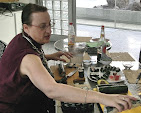Mettez cuire vostre chappon avec trumeauix de beuf, puis prendre tout le blanc de chappon et le charpire ainsi qu'on charpiroit lainne, et prendre des autres membres du chappon et mettre par pieces et les frire en sain de lart tant qu'ilz soient ung petit roux, et les dreciez en platz et mettez par dessus ladicte charpie; puis pelez amendes, broiez et deffaictes de vostre boullon et y mettez du vin blanc et du verjus; et prenez gingenbre de Mesche pare et le mettez en pouldre, et grainne de paradis le deux partz et du succre competemment et qu'il soit douix de succre; puis fault des amendes blanches pelees et les frire en sain de lart ou en sain de porc doulz, et que les amendes soient piquees dedans le potaige quant il sera drecie; et soit assez liant tant que les amendes se puissent tenir droictes; et semez par dessus de l'annis vermeil.
My translation
Cook your capon with a
knuckle of beef, then take all the white capon and shred it as you
would card wool, and with the other members of the capon pull it into
parts in parts and fry in good lard in the manner till it is not at
all pink, and arrange on a plate and spread the shreds, on top, then
peel almonds and grind and mix in with your boullion and put into it
white wine and verjuice, and take ginger of Mesche and pare it and
then make a powder, and grains of paradise in two parts, then take
fine sugar and make sweet with sugar; then take peeled white almonds
and fry them in clear beef or pork fat, and take the almonds and
prick them into the potage so they will stand upright, as the sauce
is sufficiently thick so that the almonds can stand upright, and
sprinkle over with the red anise.
1 ½ cups beef stock
lard for frying
2 cups blanched almonds (plus a handful
extra for decoration)
2/3 cup white wine (I used a “fruity
classic white”)
1/3 cup verjuice
1 gm pared then ground fresh ginger
2gm grains of paradise
1 tsp sugar
a pinch of ground star anise
Cut the chicken into large pieces.
Simmer in beef stock for about 20 minutes, until it is cooked. Strip
off the white meat of the chicken and shred it. Take the rest of the
chicken pieces and brown them in lard. Place them on a platter and
spread with the shredded white meat. T
Grind two cups of almonds and mix it
into the stock with the white wine and verjuice. Spice this sauce
with ground ginger, grains of paradise and sugar. Pour over the
chicken and then stud with blanched almonds that you have lightly
browned in lard. Sprinkle with ground star anise and serve.
A few notes on the recipe and some of the decisions made:
Anise: For this recipe, the interesting
question for me lies with the anise. In French, generally “Anise”
refers to the anise plant (Pimpinella
anisum ), which produces aniseeds. This is a green
plant,with some similarities in both appearance (and flavour) to
fennel, and is common in period in eastern Europe. However, in no
way shape or form is it red. Could the text potentially be referring
to star anise? Star anise (Illicium verum) is red. In modern
French they call star anise 'badiane', however I have found no
references within period to it being referred to as 'badiane'. Star
anise was growing in south east China but it is believed not to have
travelled to Europe until the 16th century. However, I
hypothesise that this reference to red anise may well be proof that
that star anise was in fact found in Europe much earlier than is
generally understood.
Capons: One of the sad limitations of living in
Australia is that you cannot purchase capons (I gather that it is an
animal cruelty issue - apparently it is less cruel to kill baby cocks
and throw them away than to desex them and let them grow up and then
eat them). So this recipe uses chicken.
Knuckle of Beef: I have also used beef stock rather than
cooking the chicken with an actual knuckle of beef. I also broke up
the chicken into pieces before cooking – this is not indicated in
the recipe but is a sensible thing to do to fit the chicken in a pot!
Wine: The sweeter choice of wine blended
perfectly with the verjuice and the finished sauce was seriously
tasty.



**Another thought though (May 2016) is that "vermeil" in modern French parlance is used to describe silver gilt... could this be gilded anise seeds?
ReplyDelete